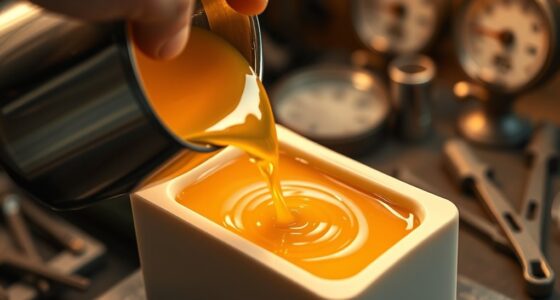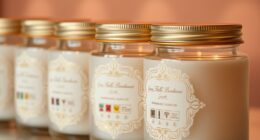I am intrigued by the mysteries of a candle’s flame and driven to accurately determine how long it burns. As I delve into the complex world of wax creations, my aim is to shed light on the factors that control a candle’s lifespan.
From the composition of the candle to the size and shape, wick type, and environmental influences, a multitude of variables intertwine to determine its burn time.
The candle’s composition, a delicate dance of wax and additives, plays a pivotal role in its endurance. Beeswax, soy, and paraffin wax each possess distinct qualities that impact burn time. Likewise, the size and shape of the candle wield their influence. A slender taper may flicker away swiftly, while a stout pillar may endure for hours on end.
Engaging in the enigma of wicks, I explore the impact of their type and quality. Cotton, hemp, and wood wicks, each with their unique characteristics, can alter the burn rate. Environmental factors, such as temperature and airflow, further shape the candle’s lifespan.
By unraveling the secrets of burning techniques, wax variations, and safety precautions, this exposé will debunk common myths and misconceptions surrounding a candle’s burn time. So, my fellow flame enthusiasts, join me on this illuminating journey as we demystify the intricacies of a candle’s captivating combustion.
Key Takeaways
- Candle composition, including the type of wax and additives, determines the burn time of a candle.
- Factors such as the size and shape of the candle, wick type, and environmental conditions like temperature and airflow influence the burn time.
- Scented candles generally have a shorter burn time compared to unscented candles.
- Proper burning techniques and using accessories like candle snuffers, trays, and holders can help maximize the lifespan and performance of a candle.
The Composition of the Candle
You may be curious about the composition of the candle and how it affects its burning time. The candle composition plays a crucial role in determining how long a candle will burn.
The main components of a candle are wax, wick, and additives. Wax, usually made from paraffin or beeswax, is the fuel that sustains the flame. Different types of wax have varying burn times, with beeswax candles typically lasting longer than paraffin candles.
The wick, made of braided cotton or another fibrous material, acts as a channel for the melted wax to be drawn up and vaporized, creating the flame. The length and thickness of the wick also affect the burning time, with longer and thicker wicks burning faster.
Additives, such as stearic acid or fragrance oils, can be included in the candle manufacturing process to modify burn time, scent, and color. These additives can either extend or shorten the burning time.
Now, let’s delve into how the size and shape of the candle further influence its burning characteristics.
Size and Shape of the Candle
Lit in the darkness, the flickering flame dances and sways, its size and shape determining the duration of its mesmerizing glow. The burn time of a candle is directly influenced by its physical attributes, such as its size and shape. A larger candle typically burns for a longer period of time compared to a smaller one. The amount of wax present in the candle directly affects its burn time, as a larger candle contains more fuel to sustain the flame.
Additionally, the shape of the candle can also impact its burn time. Candles with a larger surface area tend to burn faster due to the increased exposure of wax to the flame. Conversely, candles with a smaller surface area may have a longer burn time. The melting rate of the wax is also influenced by the shape of the candle, as a wider candle may melt more slowly compared to a thinner one.
As we transition into the next section about wick type and quality, it’s important to consider how these factors can further affect the burn time and overall performance of a candle.
Wick Type and Quality
When considering the wick type and quality, it’s crucial to understand how these factors can significantly influence the duration and performance of your candle’s mesmerizing glow.
The wick type plays a vital role in determining the burning time of a candle. Different wick types are designed for specific purposes, such as long burning or self-trimming. Cotton wicks, for example, are commonly used in candles due to their efficient and clean burn. They’re known for their ability to hold and release the melted wax evenly, promoting a longer burn time. On the other hand, wicks made from other materials like hemp or wood can also provide unique burning experiences, but they may have different burning times compared to cotton wicks.
In addition to the wick type, the quality of the wick is equally important. A high-quality wick is crucial for a clean and consistent burn. A poorly made wick may result in uneven burning, excessive smoke, or even the candle extinguishing prematurely. Choosing a wick that matches the size and composition of your candle is essential to ensure optimal burning time and performance.
Considering the wick type and quality is just one aspect of understanding how long a candle can burn. Environmental factors, such as ambient temperature and air circulation, also influence the burning time of a candle.
Environmental Factors
When considering the environmental factors that can affect the burn time of a candle, three key points come to mind: drafts and airflow, temperature, and humidity.
Drafts and airflow can cause a candle to burn unevenly or even extinguish prematurely.
Temperature plays a crucial role as well, as a cooler environment can slow down the burning process while a warmer environment can accelerate it.
Lastly, humidity levels can affect the burning rate of a candle, with higher humidity potentially causing the wick to struggle to draw up the liquid wax.
Drafts and Airflow
To maximize the burn time of your candle, you’ll want to make sure drafts and airflow are minimized so that the flame can steadily consume the wax without interruption.
Drafts can significantly affect candle performance as they cause the flame to flicker and burn unevenly. This can result in a shorter burn time and wasted wax.
Airflow also plays a crucial role in candle flame behavior. When there is excessive airflow, it can cause the flame to burn more rapidly, consuming the wax at a faster rate.
By keeping your candle in a draft-free area and away from open windows or fans, you can ensure a longer and more efficient burn.
Now, let’s explore how temperature influences the burn time of a candle.
Temperature
Maintaining a consistent temperature creates the ideal environment for a candle to beautifully illuminate any space. The temperature plays a crucial role in determining the burn time of a candle. Generally, a higher temperature will cause the candle to burn faster, while a lower temperature will slow down the burning process. This is because heat accelerates the rate at which the wax melts and evaporates, leading to a faster consumption of the candle.
Other factors affecting the burn time include the type and quality of the wax, the size and shape of the candle, and the presence of any additives or fragrances. Understanding how temperature affects candle burning speed is important in maximizing the lifespan of a candle.
Moving on to the next section about humidity, it’s worth exploring how moisture in the air can impact the burn time of a candle.
Humidity
In a humid environment, you’ll notice the air feels heavy and dense, creating a damp atmosphere that can affect the way your candle’s flame dances and flickers. Humidity can have several effects on your candles, particularly when it comes to storage. Here are three key points to consider:
-
Increased moisture: High humidity levels can lead to excess moisture being absorbed by the candle wax. This can result in a softer wax consistency, making it more difficult for the wick to draw up the melted wax and maintain a steady flame.
-
Reduced burn time: The presence of moisture in the air can cause the candle to burn at a faster rate. This means that your candle may not last as long as it would in a drier environment.
-
Sooty residue: Humidity can contribute to the formation of sooty residue on the container or surrounding surfaces. This can be unsightly and may require additional cleaning.
Considering these humidity effects on candle storage, it’s important to also explore burning techniques and practices to ensure optimal burn performance and longevity.
Burning Techniques and Practices
As the flame dances upon the wick, the candle unveils its secrets, revealing the artistry of burning techniques and practices. Proper burning techniques are essential for maximizing the lifespan and performance of a candle.
One key aspect is to trim the wick to ¼ inch before each use. This ensures a clean and controlled burn, preventing excessive sooting and mushrooming. Additionally, keeping the candle away from drafts and flammable materials prevents uneven burning and potential accidents.
Candle maintenance also plays a crucial role in achieving optimal burning. It’s important to keep the wax pool free from debris, such as matchsticks or wick trimmings, as these can interfere with the flame and cause uneven burning. Regularly checking the candle for signs of tunneling, where the wax only burns down the center, is also important. To prevent tunneling, allow the candle to burn for at least one hour per inch of diameter during each lighting session. This allows the entire surface to melt, promoting an even burn and preventing waste.
Transitioning into the subsequent section on scented candles vs. unscented candles, it’s vital to consider how burning techniques and practices can differ between the two types.
Scented Candles vs. Unscented Candles
Enhance your sensory experience with scented candles, infusing your space with captivating aromas that transport you to another world. When it comes to choosing between scented and unscented candles, there are a few factors to consider. One important aspect is the burn time comparison. Scented candles typically have a shorter burn time compared to unscented candles. This is because the fragrance oils used in scented candles can affect the rate at which the wax melts. On the other hand, unscented candles tend to burn longer as there are no additional components that can impact the burning process.
In addition to burn time, fragrance intensity is another crucial factor to take into account. Scented candles offer a wide range of fragrances, from soothing lavender to invigorating citrus. The fragrance intensity can vary depending on the type of candle and the concentration of fragrance oils used. Some people prefer a subtle scent that lingers in the background, while others enjoy a more potent aroma that fills the entire room.
Transitioning into the subsequent section about different types of wax, it is important to note that the type of wax used in a candle can also affect its burn time and fragrance intensity.
Different Types of Wax
Experience a sensory journey with scented candles, but have you ever wondered what different types of wax can offer to enhance that experience? When it comes to candles, the type of wax used can greatly affect the overall performance and burn time.
There are several different types of wax commonly used in candle making, each with its own unique properties.
One popular type of wax is paraffin wax, which is derived from petroleum. Paraffin wax is known for its ability to hold and release fragrance, making it a great choice for scented candles. It also has a high melting point, which means that candles made from paraffin wax tend to have a longer burn time compared to other waxes.
Another type of wax commonly used is soy wax, which is made from soybean oil. Soy wax is a natural and renewable resource, making it a popular choice for eco-conscious consumers. It has a lower melting point than paraffin wax, which means that soy candles tend to have a shorter burn time. However, soy wax has excellent fragrance throw and burns cleaner than paraffin wax.
Beeswax is another type of wax that is often used in candle making. It is a natural wax produced by bees, and it has a distinctive sweet scent. Beeswax candles have a long burn time and produce a warm, natural glow. However, they tend to be more expensive compared to other types of wax.
Different types of wax offer different properties when it comes to candle burn time and fragrance throw. Whether you prefer a longer burn time with paraffin wax or a cleaner burn with soy wax, choosing the right wax can enhance your candle experience.
Now, let’s explore the world of candle accessories and tools to take your candle experience to the next level.
Candle Accessories and Tools
In this discussion, I’ll be talking about three essential candle accessories and tools: candle snuffers, candle trays, and candle holders.
A candle snuffer is a tool used to extinguish candles by safely smothering the flame, preventing any hot wax from splattering.
Candle trays are used to catch any dripping wax, protecting surfaces from stains and damage.
Candle holders, on the other hand, provide a stable and secure base for candles, preventing them from tipping over and causing accidents.
Candle Snuffers
Candle snuffers are a popular tool used to extinguish candles without blowing them out, and they can increase the lifespan of a candle by 30%. When using a candle snuffer, it’s important to know that there are alternatives available.
Some people opt for candle extinguishers or candle wick dippers as alternatives to snuffers. Candle snuffers come in various designs, such as the traditional bell-shaped snuffer, the long-handled snuffer, and the snuffer with a built-in candle tray. The bell-shaped snuffer is the most commonly used design, allowing for easy access to the flame. The long-handled snuffer is ideal for reaching candles in tall candle holders. The snuffer with a built-in candle tray is convenient for catching any dripping wax.
Moving on to candle trays…
Candle Trays
Utilizing a candle tray is like providing a sturdy foundation for a flickering flame, ensuring the surrounding area remains free from wax spills and potential fire hazards. These decorative trays are specifically designed to hold candles, acting as a protective barrier between the flame and any surfaces that could be damaged by hot wax.
With a candle tray, you can create a stunning candle centerpiece without worrying about accidental spills or melted wax ruining your table or furniture. Candle trays come in a variety of materials, including metal, glass, and ceramic, allowing you to choose one that complements your candle decor and enhances the overall aesthetic of your space.
They are essential accessories for any candle enthusiast, providing both practicality and style. Transitioning into the next section about ‘candle holders,’ they offer a versatile alternative for displaying your candles.
Candle Holders
When you use a candle holder, you’ll add a touch of elegance and charm to any room. Candle holders come in a variety of materials, such as metal, glass, and ceramic. Each material offers its own unique aesthetic and durability.
Additionally, candle holders are available in various designs, including traditional, modern, and ornate styles. These designs can complement any type of decor and enhance the overall ambiance of the room. Whether you prefer a simple and sleek metal holder or a delicate and intricate glass design, there’s a candle holder to suit every taste.
As we explore the topic of candle safety precautions and tips, it’s important to consider the type of holder you use to ensure a safe and enjoyable candle-burning experience.
Safety Precautions and Tips
To ensure your safety, remember to always keep a close eye on the flame and never leave it unattended. Candle safety measures are crucial in preventing accidents and fires. Here are some important precautions to follow when burning candles:
- Place the candle on a stable and heat-resistant surface to avoid accidental tipping or heat damage to furniture.
- Keep candles away from flammable materials such as curtains, papers, or clothing.
- Trim the wick to ¼ inch before lighting to prevent excessive flickering and soot buildup.
- Avoid burning candles in drafty areas to prevent uneven burning and potential fire hazards.
- Never touch a burning candle or move it while the wax is still liquid.
- Keep candles out of reach of children and pets to prevent accidental burns or ingestion.
To provide a comprehensive overview, here is a table summarizing these candle safety measures:
| Candle Safety Measures |
|---|
| Place on stable surface |
| Keep away from flammable materials |
| Trim wick to ¼ inch |
| Avoid drafty areas |
| Do not touch or move while lit |
| Keep out of reach of children and pets |
Understanding these safety precautions is essential when considering candle burning time. Moving forward, let’s debunk common myths and misconceptions about candle burn time.
Common Myths and Misconceptions about Candle Burn Time
Contrary to popular belief, candles don’t always burn at a consistent rate throughout their lifetime. Burn time variability can occur due to several factors that affect the burning process.
One key factor is the type of wax used in the candle. Different types of wax, such as paraffin, soy, or beeswax, have varying burn rates.
Additionally, the size and shape of the candle can impact burn time. Taper candles, for example, tend to burn faster than pillar candles due to their narrower shape.
Another factor that affects burn time is the presence of additives or fragrance oils in the candle. These substances can alter the composition of the wax and affect how it burns. For instance, candles with a higher concentration of fragrance oil may burn faster than those with a lower concentration.
Environmental conditions also play a role in candle burn time. The temperature and airflow in the room can influence how quickly or slowly a candle burns. A drafty room or a higher temperature can cause the flame to flicker and burn faster.
Understanding these factors can help you predict and manage the burn time of your candles. By choosing the right type of wax, considering the candle’s size and shape, and controlling environmental conditions, you can optimize the burn time and enjoy your candles for longer periods.
Frequently Asked Questions
Can burning a candle for longer periods of time make it last longer?
Burning a candle for longer periods of time doesn’t necessarily make it last longer. The size of the candle affects its burn rate, as larger candles usually have a longer burn time. However, trimming the wick can actually make a candle burn slower and last longer. By keeping the wick trimmed to about ¼ inch, you can control the size of the flame and prevent the candle from burning too quickly.
Are there any specific candle wicks that burn brighter or longer?
There are indeed specific candle wick materials and sizes that can affect the brightness and burn time of a candle. Different materials, such as cotton or paper, can produce varying levels of brightness. Additionally, the size of the wick, such as thin or thick, can impact how long the candle burns.
By selecting the appropriate candle wick materials and sizes, one can optimize both the brightness and duration of a candle’s burn.
Do scented candles burn faster than unscented candles?
Scented candles can burn faster than unscented candles due to the added fragrance oils. The chemicals in these oils can increase the burning rate, resulting in a shorter burn time.
Additionally, scented candles can affect air quality as they release volatile organic compounds (VOCs) when burned. These VOCs can contribute to indoor air pollution and may have health risks, such as triggering allergies or respiratory issues.
It’s important to consider these factors when using scented candles.
How does the type of wax used affect the burn time of a candle?
The impact of wax composition on the burn time of a candle is a widely debated theory. I’ve found that the type of wax used can indeed affect the duration of the burn. Certain waxes, like soy and beeswax, tend to burn slower than others, such as paraffin wax.
Additionally, the size of the candle plays a role. Larger candles generally burn for a longer period of time.
Are there any specific candle accessories that can help extend the burn time of a candle?
Candle extinguishers and candle snuffers are specific candle accessories that can effectively extend the burn time of a candle. These tools allow for a controlled and gentle extinguishing of the flame, minimizing smoke and preventing wax splattering. By using a candle extinguisher or snuffer, the candle is extinguished without the need for blowing out the flame, which can cause wax to melt unevenly and shorten the burn time of the candle.
Conclusion
In conclusion, the burning time of a candle is influenced by various factors such as its composition, size, shape, wick type, and environmental conditions. By understanding the science behind candle burning and implementing proper techniques and safety precautions, one can maximize the burn time of their candles.
However, there are still common myths and misconceptions surrounding candle burn time that need to be debunked. So, next time you light a candle, remember to consider these factors and enjoy the mesmerizing glow as it slowly illuminates your surroundings, creating a calming ambiance.









